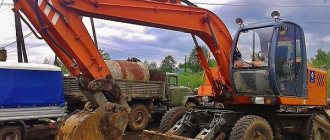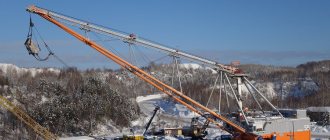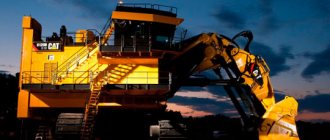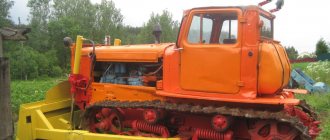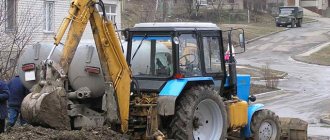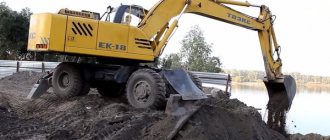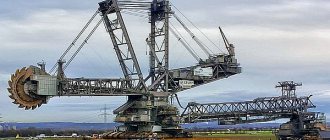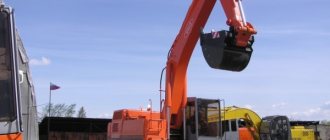Road equipment manufacturer Caterpillar will increase production of excavators in Russia. According to experts, investments in increasing capacity may exceed 300 million rubles. The project is being implemented against the backdrop of growing sales of construction equipment in Russia.
According to the Russian representative office of Caterpillar, the plant in Tosno has been assembling two models of crawler excavators for several years: Cat 320D, which is most often used for digging pits and dismantling reinforced concrete structures, and Cat 336DL, which is suitable for excavation and landscaping work.
will invest 1.5 billion rubles in the construction of a fish breeding complex in the Leningrad region Investments
will invest 1.5 billion rubles in the construction of a fish breeding complex in the Leningrad region
32273
Editorial
In the near future, Caterpillar plans to start producing two more models of excavators. The company declined to comment in detail. According to market participants, we may be talking about assembling wheeled excavators, which are more convenient when working on flat surfaces, in contrast to tracked vehicles. The project is expected to begin in 2020. The volume of investment in the project may amount to about 300 million rubles.
The American company Caterpillar produces road construction equipment, energy and mining equipment. In Russia, the company operates a production of bodies for mining dump trucks in Novosibirsk and an assembly plant in Tosno - Caterpillar-Tosno LLC. During the first quarter of 2020, the plant in the Leningrad region produced 15 excavators, five chassis for dump trucks and 1.5 thousand parts for road construction equipment. Currently, according to experts, Catrepillar produces on average about 80-100 excavators per year. The turnover of Caterpillar-Tosno LLC in 2015 amounted to 2 billion rubles.
The company mainly exports its products (more than 50%) to European and Asian countries. Parts for equipment are supplied to the corporation’s factories in Europe. As representatives of Caterpillar-Tosno LLC have already stated, product exports will not decrease for now. Nevertheless, experts believe that the market for road construction equipment in Russia has overcome the recession and the American corporation will be able to increase sales within the country. The production of two new models of excavators will allow the company to change and replace some positions in the import of its products, analysts say.
The company will also export new machines. “Foreign manufacturers reduce the cost of products for the markets of Europe and other countries by assembling and producing equipment in Russia. This allows companies to offer their products in foreign markets at a lower price,” says Managing Director of Donex LLC (excavator production) Aren Khachatryan.
ETS Holding acquired the largest distributor of spare parts for excavators Mergers and acquisitions
Scope of application of the excavator
Depending on the classification and place of application, excavators can be: for mobility - on a wheeled base, for swampy and loose soil - on caterpillar tracks, in mining - on skis or paws. Walking mechanisms are used for laying pipelines in swampy areas and for cleaning rivers and lakes.
This technique is able to work both above the platform on which it stands and below its level. It removes soil from under the water, clearing the bottom, loads it into a vehicle or pours it into a dump at a considerable distance from the excavation site.
It independently cleans the walls of trenches and pits, compacts the bottom of pits or construction sites. Their work does not require a lot of free space, which allows you to keep the surrounding area untouched.
Experts can no longer imagine performing most large-scale construction, road, and hydraulic works without this special equipment.
Tweet
Grew up
The excavator market in Russia in 2020 amounted to 1.8 thousand machines, despite the fact that at the peak of demand the capacity was more than 7 thousand machines. Including more than 1 thousand machines were imported, estimates the chairman of the committee of manufacturers of road construction equipment and special equipment of the Association of European Businesses (AEB) Andrey Komov.
He adds that 90% of excavators were supplied by large international companies (both imported and produced at Russian factories of corporations). In Russia, Caterpillar, Hitachi, Komatsu and Volvo have factories producing excavators. Russian companies produced 131 excavators last year, which is 40 more than in 2020. These are the Kovrov Excavator Plant, Saransk Excavator Plant, Donex, and Uralvagonzavod.
AEB notes that this year the road construction equipment market finally overcame a four-year crisis: sales in the first quarter increased by 29%, growth was ensured by all types of machines. Experts predict that by the end of 2020, growth will remain at the same level.
The reasons for the drop in demand in previous years are considered to be the general economic situation, high interest rates on loans, and recycling fees for special equipment. The latter was introduced in 2016. It ranges from 450 thousand to 6 million rubles per car, these amounts are paid by manufacturers and suppliers of equipment.
Constraining factors in the industry are the lack of investment in construction projects from the state, as well as constantly changing localization conditions. Due to the opacity of industry regulation mechanisms, manufacturers who planned to invest are forced to slow down this process, which ultimately negatively affects the special equipment market, says Sergei Kharitonov, development director at JCB in Russia (special equipment production).
Now the main reasons for the growth of the road construction equipment segment are the stabilization of the economy and pent-up demand. On average, construction companies updated their fleet of equipment more than 7 years ago; now they need new machines, says Aren Khachatryan.
New Russian mining excavators
On December 19, 2006, on the territory of the Voronezh Excavator Plant, a presentation of the leading samples of diesel-hydraulic excavators DGE-1200 in the “forward” and “backhoe” versions of the working equipment took place. The presentation was opened by the General Director of JSC RUSSO-BALT TYAZHEKS A.V. Samolazov, who said that the design of the two excavators presented was developed by a specialized design bureau created within the company three years ago.
The presented samples of mining excavators are the junior class of the planned family, which covers 5 classes in the operating weight range from 120 to 500 tons, with a bucket capacity range from 4 to 32 m3, power from 503 to 1900 kW. The primary task that JSC RUSSO-BALT TYAZHEKS sets for itself is to master the flagship models of the DGE1200 and DGE2800 family. The design adopts classical approaches to the layout of mining excavators. The presented samples of the DGE-1200 excavator are one of the first domestic mining excavators with hydraulic control of working equipment.
The design was initially based on the principle of using modern proven and reliable units, components and systems from the world's leading manufacturers. The production of these excavators is planned to be carried out at the production facilities of the Voronezh Excavator Plant. The chief designer of the design bureau of RUSSO-BALT TYAZHEKS OJSC A.I. reported in detail on the design solutions adopted on the DGE-1200 excavators. Sapozhnikov. He said that the DGE-1200 mining excavator was created in two versions of working equipment: “forward” and “back” shovels. Excavators equipped with main buckets with a capacity of 6 m3 are designed to work at mining and construction materials industry enterprises in a loading and transport complex with mining dump trucks with a lifting capacity of 30-55 tons. Excavators can be equipped with a diesel or electric power unit. The first pilot batch of diesel-powered excavators will be produced in 2007.
The design of the DEG-1200 excavator uses units and components from leading foreign companies: diesel engine from Cummins KTTA 19-S700; components of the hydraulic power drive, travel and rotation mechanism of the platform from Bosch-Rexroth; RoteErde slewing bearing. Metal structures of excavators are made at Russian enterprises from high-quality structural steels and are able to withstand high loads under difficult operating conditions. To ensure comfortable working conditions for the operator, the excavators are equipped with a two-seat, thermally and sound-insulated cabin with a modern control system. Excavators can be equipped with buckets with a capacity of 4; 6 and 8 m3 for excavation of rock with a density over 2.5; 1.8-2.5 and less than 1.8 t/m3, respectively. The kinematics of excavation equipment ensures the achievement of the following indicators and parameters of the face: • for a “straight” shovel:
- maximum digging height - 11.5 m; maximum digging depth - 3.2 m; maximum reach - 11.3 m;
for a backhoe:
- maximum digging height - 12.3 m; maximum digging depth - 10 m; maximum reach - 15.3 m.
Excavators of climate version UHL1 are designed for operation at ambient temperatures down to minus 55°C. Testing of prototypes is planned to begin at one of the mining and processing plants in Russia in the first half of 2007.
JSC "RUSSO-BALT TYAZHEKS" plans in 2007, using the technological capabilities of the Voronezh Excavator Plant, to produce 6-8 DGE-1200 excavators with 6 m3 buckets and to begin creating a prototype of a mining hydraulic excavator with a 15 m3 bucket for working with mining dump trucks with a lifting capacity of 120 -150 t.
During the presentation, technical and techno-economic issues of the production of hydraulic excavators DGE of JSC RUSSO-BALT TYAZHEKS were discussed.
“For the first time in the Russian Federation, the company’s technical policy provides for the development, development of serial production, supply and maintenance of a standard range of hydraulic excavators with buckets with a capacity of 4 required by mining enterprises; 6; 8; 10; 16; 22 and 32 m3 for working with dump trucks with a carrying capacity from 30 to 320 tons... RUSSO-BALT TYAZHEKS OJSC is creating a dealer network and invites for cooperation companies with experience in selling and organizing the maintenance of heavy mining equipment,” summed up the General Director of RUSSO OJSC -BALT TYAZHEKS" Alexander Viktorovich Samolazov.
V.D.Kovrigin
Magazine "Mining Industry" No. 6 2006
Mining Excavators: Hydraulic Growth
Coal mining companies in Siberia are increasingly giving preference to foreign equipment, since one of its most important characteristics is high reliability in the extreme conditions of this region. When updating the fleet of mining equipment, imported hydraulic large-cube excavators are replacing mechanical ones. Our correspondent found out what are the priorities in the technical policy of mining companies today.
Text and photo: Alexander Kolpakov
Despite the efforts of environmentalists and investments in clean energy sources, the structure of global fuel production has not changed dramatically over the past 20 years. This fact is stated in a study by the International Energy Agency. The volume of coal mined in the world is growing. Solid fuel production is also increasing in Russia. Thus, Kuzbass, one of the country’s key coal basins, came close to the symbolic milestone last year, producing 200 million tons of coal, which far exceeds the figures achieved in the basin during Soviet times. This is a historical record.
Today, many of the region's largest mining companies have announced the implementation of major investment projects to increase coal production volumes and develop new coal areas.
However, within the industry, the technology for developing solid fuel reserves using a system for removing coal and rocks by road, which is acceptable in various mining and geological conditions, still dominates. This system in Kuzbass accounts for 84% of open-pit coal production. The picture is similar in other coal-mining regions of the country.
In this technological scheme, one of the key links in the transport and mining chain is a mining excavator. However, the region has a very old fleet of this equipment. Experts note that her age often exceeds 15–20 years. It is obvious that the technological park of coal mining enterprises needs to be updated. According to medium-term forecasts of industry analysts, the growth of the quarry park in the Russian Federation will be slightly higher than in other countries of the world by an average of 3%.
Trends in context
The trend that has emerged at the coal enterprises of the region is the replacement of the fleet of excavation equipment (mechanical excavators are replaced by hydraulic ones) - requires large investment injections. Since excavators are quite unique equipment, when developing new areas of coal deposits, hydraulic large-cube mining excavators are mainly used.
This trend is easy to explain. Why are hydraulic machines superior to mechanical ones?
Nowadays, more than 60% of quarry mechanical shovels are excavators with buckets of 5–15 cubic meters. m. On the one hand, this morally and often physically outdated equipment is characterized by simplicity and reliability. On the other hand, a hydraulic mining excavator still solves production problems more flexibly. The weight of a hydraulic mining excavator is less; it is equipped with both a “forward shovel” and a “reverse shovel”. It benefits from higher specific power and mobility, which allows for high-quality selective excavation of rock. Hydraulic mining excavators are actually no longer inferior in reliability, and new models are superior to their mechanical competitors. An important argument is the initial cost of the equipment. The use of mining hydraulic excavators with large unit power and bucket capacity in combination with heavy-duty dump trucks allows for high production rates and increased productivity while reducing the overall fleet of excavation and loading equipment. Therefore, such rearmament is a natural process. This first led to a massive displacement of mechanical excavators in the class with a basic bucket of up to 10 cubic meters. m, and then in a higher class, especially in newly opened open-pit mines and quarries.
According to the OS , today hydraulic excavators for the mining industry with a bucket volume of up to 20 cubic meters are available. m accounts for about 70% of orders. But for now, if the bucket size exceeds 30 cubic meters. m, then hydraulics loses its advantages over mechanics. The growth of the hydraulic excavator market is about 5%, and sales volumes of imported equipment are growing an order of magnitude higher - 50–60%. The factors behind this accelerated growth are the freedom of choice of equipment by mining companies, the development of dealer networks of foreign manufacturers, as well as reliability, productivity and competitive cost of standard maintenance hours and efficiency.
Small quarry and construction
The leaders in demand among hydraulic mining excavators for quarry purposes are foreign brands - Liebherr , Caterpillar , Hitachi , Komatsu , Bucyrus , etc. We also note the penetration of Korean and Chinese mining excavators into the segment.
Most of the models of heavy hydraulic diesel mining excavators are presented “on the border” of universal (construction) and mining machines, which can be used both on large construction sites and in mining.
Such typical models of dual-purpose mining excavators include those in the Komatsu
model
PC750 . The mining excavator belongs to the Dash-7 . For Western markets with strict requirements for exhaust emissions and noise, Komatsu offers the next generation - Dash-8 . The power plant of the mining excavator is a six-cylinder in-line diesel engine Komatsu SAA6D140E-3 - aggregated with a tandem axial piston hydraulic pump and a feed gear pump. Both the functionality of a mining excavator and its efficiency, which during a year of operation is calculated in tons of saved fuel, depend on the optimal regulation of engine speed and hydraulic pump supply. For this purpose, two main operating modes are provided - active and economical. Each mode corresponds to a certain engine speed, pump flow and system pressure, which depend on the task being performed. RS750-7 mining excavator , equipped with a “straight shovel”, is equipped with a 4600 mm boom, a 3400 mm handle and buckets with bottom unloading with a capacity of 4.5 or 5.1 cubic meters.
m. In the model range of another Japanese manufacturer Hitachi
the class of 80-ton machines is represented by
ZX-850/870-3 . Isuzu AH6 engine with a power of 540 hp.
The hydraulic system has been thought out: two axial piston pumps of variable capacity, maximum flow 2x528 l/min. The oldest model in the Volvo
.
The Volvo EC700C crawler excavator is more of an 80-tonne excavator. Efficient design, high energy availability and perfectly balanced hydraulics make it possible to work in a small quarry with difficult mining and geological conditions. Bucket capacity – 4.6 cubic meters. m. The engine combines well with complex hydraulics. Access to the engine and hydraulics is good. Location of units at ground level reduces maintenance time. Thanks to the large counterweight and long wide tracks, the EC700B has high stability in difficult working conditions. To reduce transport costs, the tracks can be retracted. Despite being designed for tough conditions, the EC700B delivers productive cycles, is fuel efficient and has high digging force.
In the line of the German company Liebherr
Equally versatile models include the R 974 B crawler excavator, which allows the machine to be used exemplarily in quarries and small open-pit mines thanks to the proven principle of combining high-strength prefabricated steel structures and cast steel components. Additionally (optional), the offered SME version is specially adapted for use in quarry conditions thanks to reinforced equipment components and chassis. The eight-cylinder engine of our own production develops a power of 536 hp, is specially designed for use both on construction sites and in open-pit mining, equipped with reliable hydraulics, a working pump and a travel drive, which guarantees high results from the use of this machine in the context.
Among the trends, we note the entry into this segment of equipment by manufacturers from China and South Korea. Three models of mining excavators from the Korean company Hyundai
belong to the class of 80 tons and above.
And the oldest model, Hyundai R1200-9 , belongs to the 120-ton class. Korean excavators are equipped with six-cylinder Cummins producing 740 hp.
6.7L buckets. The equipment is adapted for use in Russian conditions. Increasing bucket to maximum
There is a clear tendency to increase the size of quarry hydraulic equipment, including hydraulic excavators. It is no longer a secret that in coal mine parks, as part of investment projects for renovation and development of new highly productive seams, the operation of high-performance foreign equipment has begun.
In the largest industrial holding of Kuzbass "SDS-Ugol", the technological park of the open-pit mines "SibEnergoUgol" , "Kiselevsky" and "Prokopyevsky coal mine" Hitachi
EX-3600 excavators (21 cubic meters); EX-2500 (15 cubic meters). Pervomaisky coal mine , put into operation in May 2012, was initially equipped with high-performance equipment: modern Hitachi , as well as EX-5500 (27 cubic meters); EX-3600 (21 cubic meters); EX-2500 (15 cubic meters) are paired with mining dump trucks with a carrying capacity of 220–240 tons. P&H-2800 excavators (33 cubic meters).
The picture is similar in other sections of the region. The model lines of the world's leading manufacturers include such equipment. Liebherr mining equipment
There are eight cars with different characteristics.
The most powerful and productive mining machine in the line is the R9800 , which belongs to the 800-ton class.
Engine 4000 hp The high productivity of this machine is ensured by a 42 cubic meter bucket. m. However, such foreign giants are far from isolated in the coal mines of Kuzbass and other basins of the country. At the end of last year, P&H
2800 excavator was assembled and started working at Chernigovets . This American model of a 1100-ton mining excavator is designed for work in coal fields. Among the features, we note the video monitoring system. The image from four video cameras, transmitted to the monitor in the cabin, allows the driver to control the situation even in the so-called blind spots. The excavator's operation is monitored using the P&H Centurion . The operating parameters of all machine systems are displayed in real time on the touch panel in the cab and on the enterprise server. Remote maintenance of the excavator is carried out through the PreVale .
The parameters and characteristics of the excavator are impressive. Scooping height – 16.6 m, unloading – 9.1 m. Bucket capacity – 33.6 cubic meters. m. Now we are talking about three similar mining excavators at this mine. In particular, the mining excavator is faced with the task of increasing the volume of stripping work to 1 million cubic meters. m monthly. Of course, such gigantic machines, capable of turning over millions of cubic meters in a month of operation, are not needed at every coal enterprise. Mining and geological conditions dictate not only mining methods, but also the production capacity of a coal mine. And at the new promising Elginskoye coal deposit in Yakutia, the most powerful of the Komatsu
PS8000 excavator . The miners intend to extract up to 30 million tons of coal per year from this deposit. To ensure this level of production, the heaviest class of excavators from the Komatsu . The choice fell on the Japanese model, since it has been known for more than 30 years and has proven itself well in the open-pit mines of the South Yakutsk coal basin. To work at the new field, the company hired Komatsu : two Komatsu PC-8000 with a 36 cubic meter bucket.
m, as well as heavy dump trucks and other equipment. Caterpillar mining excavator should be noted
, presented in the USA.
The largest mining excavator has appeared in the model line of the American manufacturer Caterpillar - Cat 6120B H FS . The operating weight of the ultra-class mining excavator with hydraulic drive Caterpillar 6120B H FS is 1270 tons, the engine power is about 4500 hp, which allows the excavator to effectively operate a bucket with a volume of 46–65 cubic meters. m depending on the density of the material. A hybrid scheme is used here. The energy management system uses large capacitors to store the energy generated by the excavator as it slows down the swing and lowers the bucket. This stored energy then helps power the hydraulic system when the machine is operating at peak power – for example during the excavation phase. Hybrid technology, like other mining shovel systems, features long-life components and a design that simplifies maintenance. The 6120B H FS mining shovel's insulated, modular systems provide ease of access and improved serviceability.
Average career
In coal mines, where production capacity does not reach production volumes of several tens of millions of tons per year, excavators with an operating weight of 100 to 300 tons are usually used. Such equipment is represented quite widely in the model lines of the world's leading manufacturers. According to experts, sales of equipment of this class will show growth in the future. For example, in 2013, the Japanese corporation Hitachi expects to sell 170 hydraulic mining excavators with an operating weight of up to 120 tons and above and another 240 excavators of a heavier class - 190–800 tons.
Last year, Komatsu PC2000 mining excavator was put into operation Krasnogorsky . The car is equipped with a turbocharged diesel engine and direct fuel injection. The engine power is 717.85 kW. The RS 2000-8 excavator belongs to the class of 200-ton machines. It is noteworthy that the bucket of the new technology has been strengthened for working with rock and abrasive rocks. In addition, it is possible to equip with additional tools to start the automatic fire extinguishing system and diesel at low temperatures.
A little earlier, a similar model was put into operation by the Siberian Coal Company at the Tunguisky . The excavator has an 8 cubic meter bucket. m, holding up to 12 tons of rock. Diesel engine with 956 hp. The fuel tank holds enough fuel for continuous 24-hour operation.
